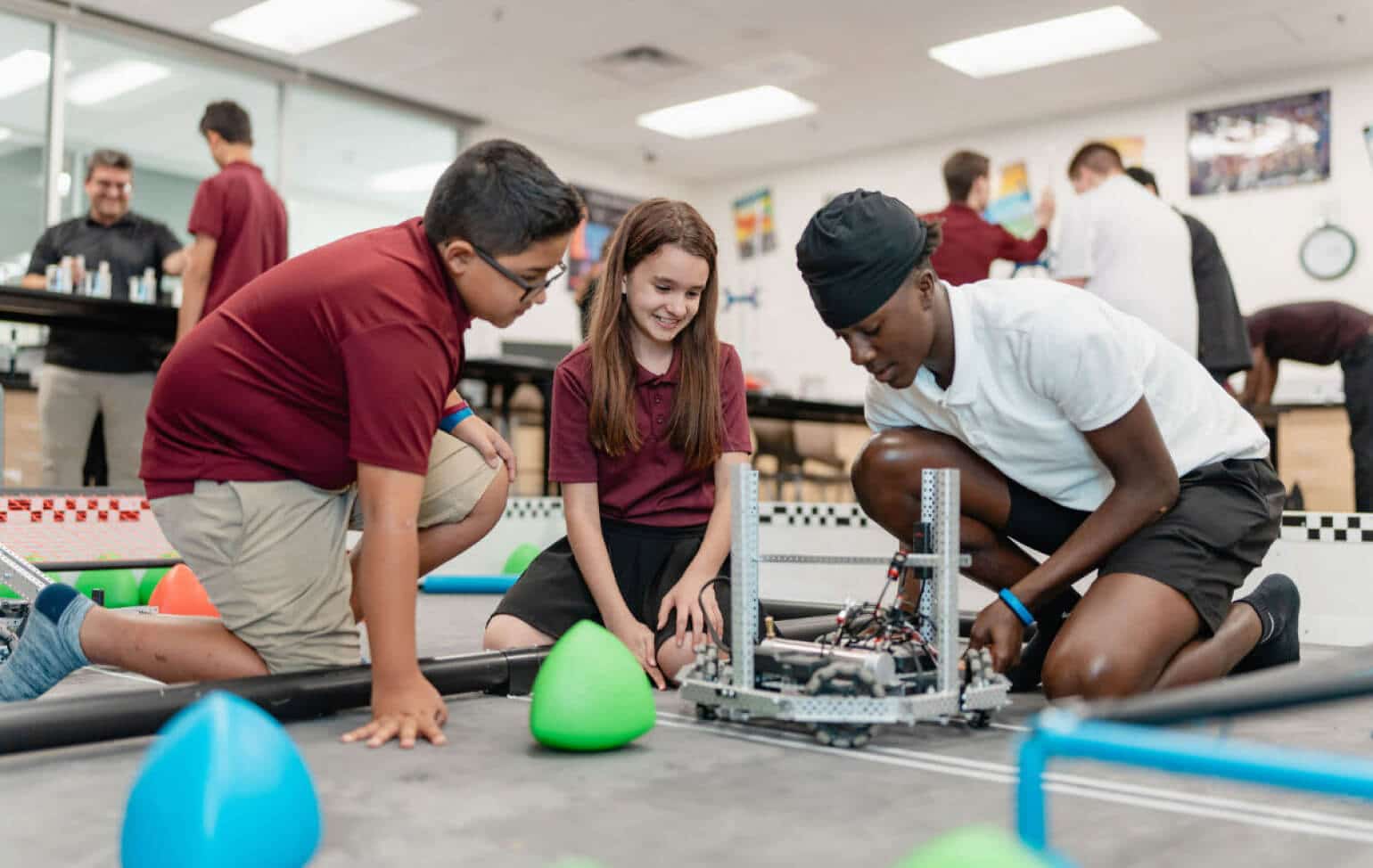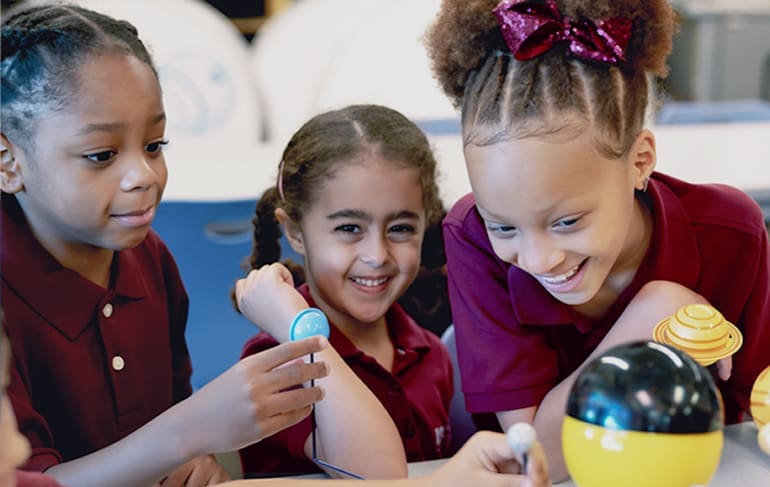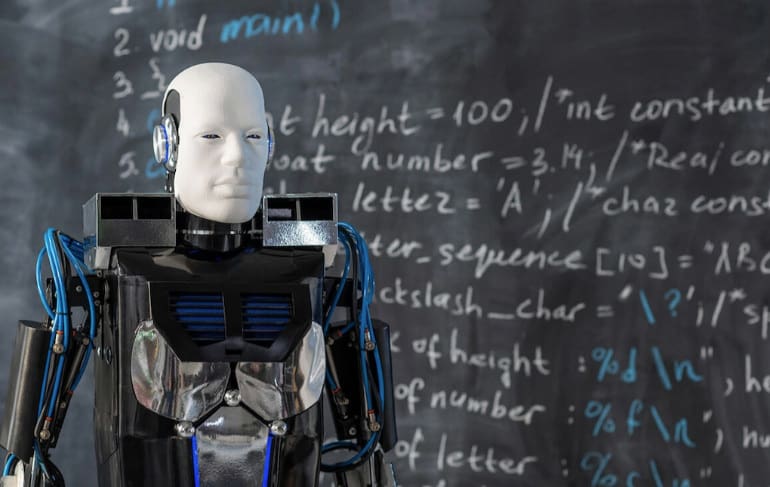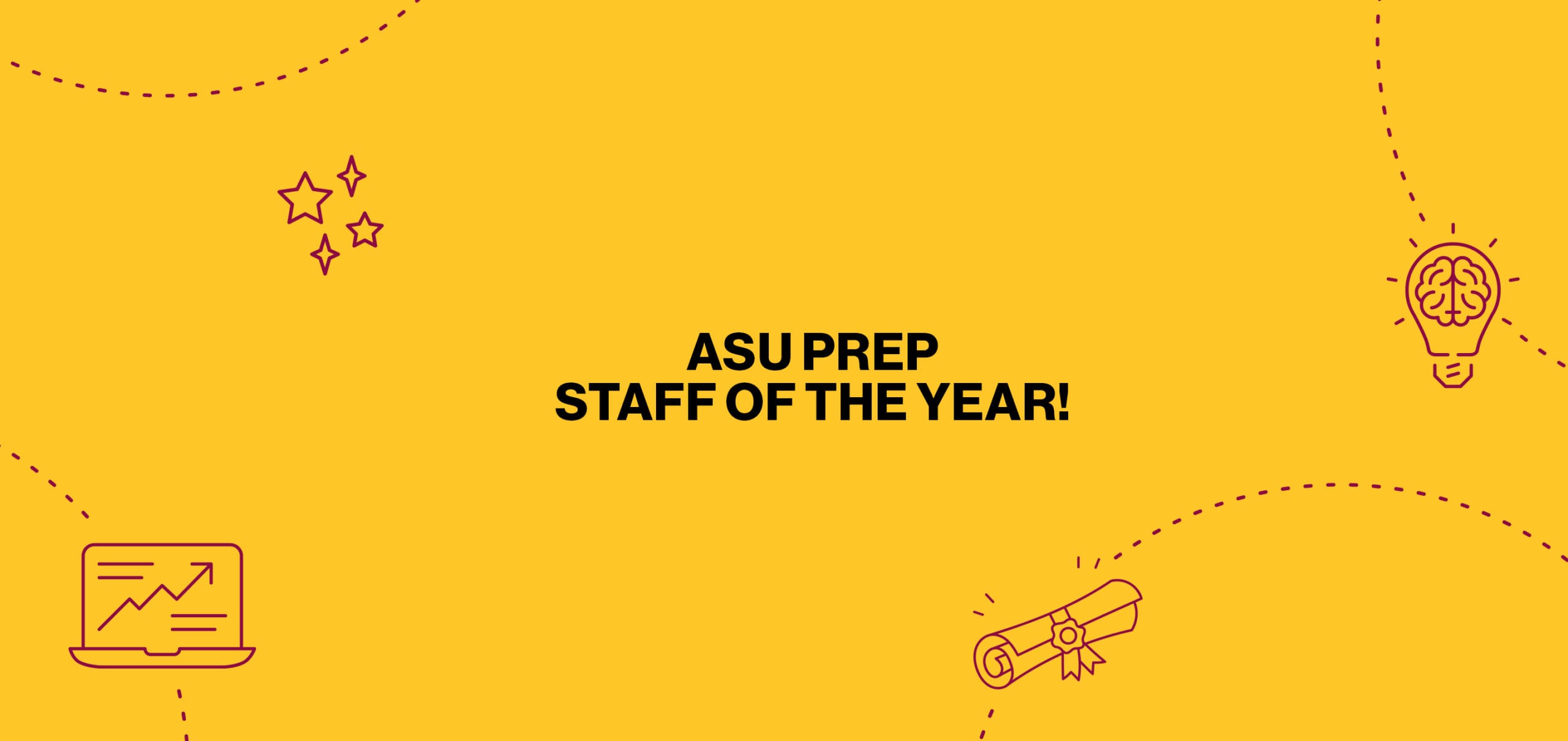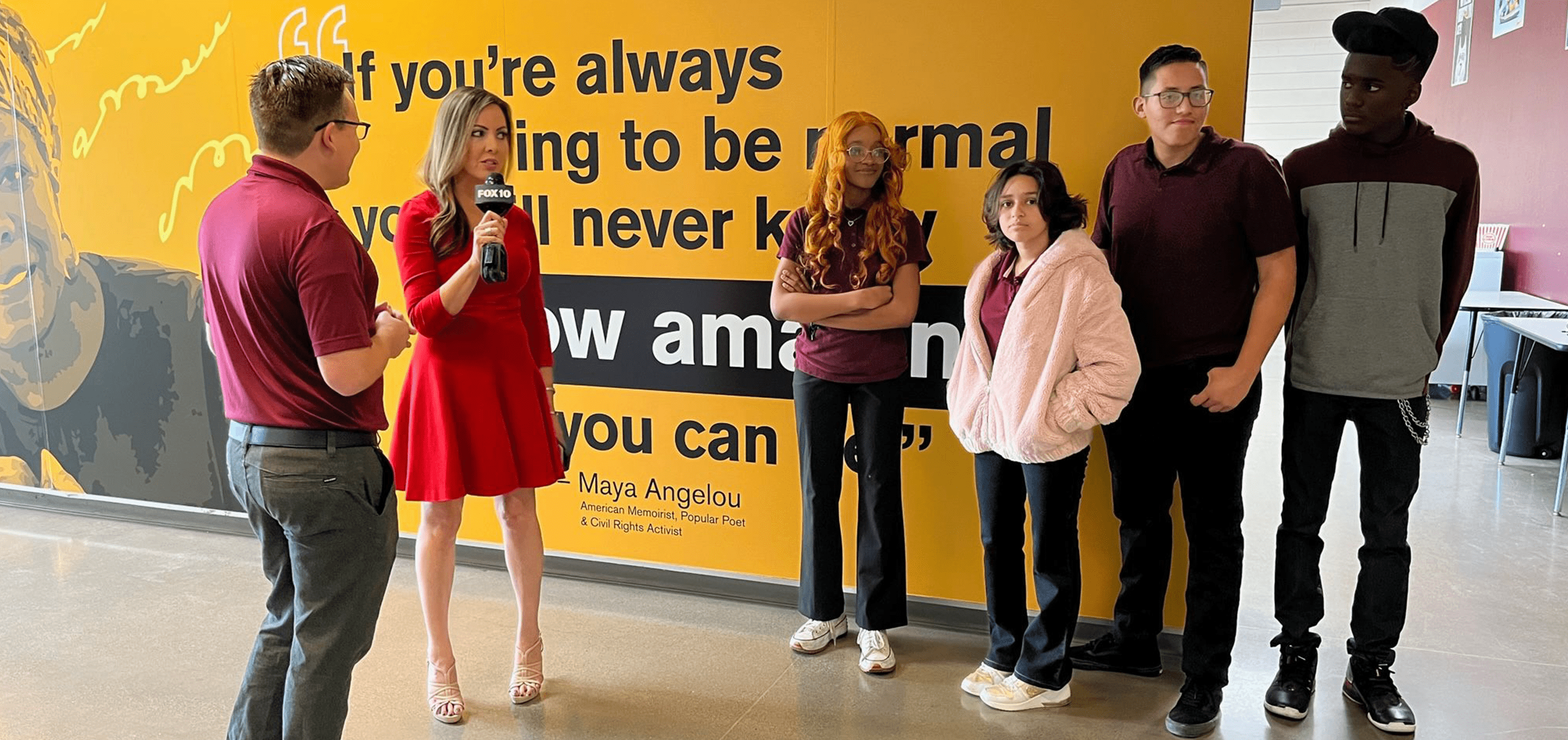News
News/h2>
Weekly Family Newsletter, 7/2/25
Learn MoreFrom the Desk of Principal Emma Popish: Summer 2025
We’re so excited to see our students back on campus and to partner with you for an amazing year ahead.
Learn MorePBS Arizona highlights ASU Prep Poly STEM robotics team’s World Championship win
ASU Prep Poly STEM all-girls robotics team was featured on PBS Arizona for earning top honors at the Create Jr. U.S. Open World Championships.
Learn MoreMore than 3,000 Valley students explore high-tech careers at ASU Prep event
More than 3,000 students explored semiconductors through VR and hands-on activities at Semiconductor Adventure Day with ASU Prep.
Learn MoreSummer Camp for Neurodivergent High School Students
Learn MoreIntroducing ASU Prep Polytechnic’s Transformational Teacher Leaders
The Transformational Teacher Leader (TTL) program is an exciting initiative empowering top-notch educators to shine both in the classroom and as community leaders.
Learn MoreASU Prep’s Family Choice Day: More choice, unlimited possibilities
Family Choice Day at ASU Prep schools gives students the flexible option of at-school or at-home learning on Fridays
Learn MoreA decade strong: ASU takes top spot in innovation for 10th year in a row
For the 10th year in a row, Arizona State University is No. 1 in innovation in the newly released annual “Best Colleges” 2025 rankings by U.S. News & World Report — just one of many top rankings earned by the university.
Learn MoreTop-rated preschools in Mesa, AZ 2024
Discover top-rated preschools in Mesa, AZ. Equip your child with a strong educational foundation to pave their way to college success.
Learn MoreRacing into the future with ASU Prep Poly 5th grader William Macdonald
ASU Prep Poly student epitomizes STEM learning by planning and hosting school-wide coding robot race.
Learn MoreASU Preparatory Academy Poly STEM Elementary earns prestigious A+ School of Excellence Award
ASU Prep Academy Poly STEM Elementary named A+ School of Excellence for offering exceptional K–6 education.
Learn MoreASU Honors Black History Month with Community Events
Black History Month is an annual celebration of the profound contributions that African Americans have made to all facets of society.
Learn MoreASU Prep Poly celebrates milestone Sweet 16 birthday
ASU Prep Poly celebrates sixteen years of PreK–12 STEM-based, innovative, and personalized education.
Learn MoreStrong foundations start in Kindergarten.
Learn about our innovative Kindergarten program at an upcoming information-packed session at one of our four elementary locations in the metro Phoenix area.
Learn MoreUpcoming ASU Prep Neighborhood Events
At ASU Prep, we believe that a strong and vibrant community is fundamental to the success of our students!
Learn MoreDía de los Muertos event celebrates the magic of tradition and community
ASU Prep K–12 tuition free public school honors tradition and encourages family involvement with its Día de los Muertos community event.
Learn MoreThe legacy lives on: celebrating Native American Heritage Month
ASU Prep celebrates the history of Native American Heritage Month with ways to learn and honor the many contributions of indigenous people.
Learn MoreAccelerating Math Skills: ASU Prep’s Math Momentum Program
ASU Prep’s innovative Math Momentum program offers personalized education strategies, boosting math skills in Arizona schools.
Learn MoreASU Prep’s Science of Reading training program is empowering educators and achieving student success
Ensuring students can read proficiently is a critical goal for schools and educators.
Learn MorePractical STEM education for high school students: the EPICS program
Get to know the ASU Prep’s EPICS program, connecting students to practical STEM education, real-world STEM experiences, potential STEM careers.
Learn MoreExciting news: ASU Prep Global named a 2023 Yass Prize Semifinalist!
ASU Prep Global is proud to be named a 2023 Yass Prize Semifinalist, selected from nearly 2,000 applications representing 27 million students in grades PreK–12 across all 50 states.
Learn MoreTo Be Globally Competitive, the U.S. Must Value STEM as Much as Literacy
K-12 education needs to be rethought and redesigned: The engine for STEM learning is curiosity and imagination.
Learn MoreHere’s how Arizona teachers are adapting — not attacking — AI
“We’re like the happy cheerleaders for AI," said Janel White-Taylor, clinical professor at Mary Lou Fulton Teachers College.
Learn MoreSchools Worth Visiting
For many years (at least until 2020), we visited about 100 innovative schools a year.
Learn MoreASU Prep Global, trailblazer in education, announced as Yass Prize Quarterfinalist
ASU Prep Global is proud to be named a 2023 Yass Prize Quarterfinalist, a prestigious recognition from the Yass Foundation for Education.
Learn MoreASU ranked No. 1 in innovation for 9th straight year
For the ninth year in a row, Arizona State University is No. 1 in innovation among American universities, ahead of Stanford, MIT and Caltech, in the newly released annual “Best Colleges” 2024 rankings by U.S. News & World Report.
Learn More9/11 is Patriot Day: a National Day of Service and Remembrance
September 11, 2001 is a day that will forever be etched in the hearts and minds of Americans.
Learn MoreCelebrate Hispanic Heritage Month
Every year from September 15 to October 15, the United States celebrates National Hispanic Heritage Month.
Learn MoreWelcome Lori Frazier
ASU Preparatory Academy is thrilled to introduce Principal Lori Frazier. With over 20 years of extensive educational experience spanning grades K–12, Dr. Frazier brings a wealth of expertise in both general and special education.
Learn MoreExcellence in Education
We are shining a spotlight on two remarkable individuals who have been recognized for their outstanding contributions to ASU Prep.
Learn MoreDiscover New Reads Just in Time for Book Lovers Day
Picture a cozy nook as you immerse yourself in the pages of a captivating story. Welcome to the enchanting realm of Book Lovers Day, a celebration of literature and the transformative power of reading, recognized on August 9.
Learn MoreASU Prep’s Internship Program: Setting up Students for College and Career Success
In honor of National Intern Day on July 27th, we want to shine a spotlight on ASU Prep's internship program, designed to support high school students on their journey toward higher education and fulfilling careers.
Learn MoreSummer Tips: Get Kids Out of the House
Learning should be - and can be - fun. Summer is the perfect time to engage your learners in meaningful opportunities to be curious, to explore, and to discover new interests.
Learn MoreMinority Mental Health Month: Tips for Prioritizing Wellness
Observed in July, National Minority Mental Health Month brings awareness to the unique challenges faced by our nation’s varied minority groups.
Learn MoreNurturing Children’s Mental Health
ASU Prep recognized May 11th as National Children’s Mental Health Awareness Day, which highlights the importance of children’s positive mental health as part of their overall development.
Learn MoreCelebrating Teacher Appreciation Week at ASU Prep
Thank you to all our hard-working ASU Prep Academy staff and teachers who most definitely deserve extra credit.
Learn MoreAnti-Bullying Tips for a Positive Community
ASU Prep does not tolerate bullying, harassing or intimidating others on school grounds, school-sponsored events, or through use of technology.
Learn MoreHelp Us Celebrate Our 2023 Teacher of the Year Nominees
We are thrilled to announce the nominees selected for ASU Preparatory Academy’s 2023 Teacher of the Year. Meet our exemplary educators.
Learn MoreCheers to Our 2023 Staff Member of the Year Nominees
On behalf of ASU Preparatory Academy, we want to recognize our outstanding education support personnel for their significant contributions to our school and students. Meet our incredible 2023 Staff Member of the Year nominees:
Learn MorePassover: Celebrating Freedom and Family
Students of all religions, cultures, and beliefs call ASU Prep home, and we are honored to include and welcome them.
Learn MoreChristians Celebrate Easter with Hope and Joy
Christians around the world celebrated Easter this past Sunday, which commemorates the resurrection of Jesus on the third day after his crucifixion.
Learn MoreASU Preparatory Academy’s Innovative People, Programs Earn High Honors at 2023 Edtech Awards
A forward-thinking, innovative approach to education is once again earning accolades for ASU Preparatory Academy and its leadership team.
Learn MoreASU Honors Black History Month with Community Events
Black History Month is an annual celebration of achievements by African Americans and a time for recognizing the central role of Black people in U.S. history.
Learn MoreForbes names ASU one of Best Large Employers in US
On Feb. 15, Forbes listed Arizona State University as one of America’s Best Large Employers for 2023.
Learn MoreForbes names ASU one of Best Large Employers in US
On Feb. 15, Forbes listed Arizona State University as one of America’s Best Large Employers for 2023.
Learn MoreASU Prep Clubs Session 4 Now Open
If you are interested in a club that starts in session 4, please complete the Interest Link in and you’ll receive additional information.
Learn MoreKindness Week is Feb. 13-17
One random act of kindness leads to a chain reaction which improves our connections with others and ourselves.
Learn MoreASU Preparatory Academy South Phoenix Art Inspires Students
ASU Preparatory Academy South Phoenix students returned from fall break to find some unexpected inspiration on campus.
Learn MoreConvergence of Technology and Personalization Play a Critical Role in the Future of Education
Julie Young has been celebrated as an education disruptor for nearly three decades.
Learn MoreWelcome Stephen Rothkopf
ASU Preparatory Academy is pleased to welcome Stephen Rothkopf to the team.
Learn MoreChristians Celebrate Easter with Hope and Joy
We recently received a letter from a proud parent whose daughter just graduated from ASU Prep with honors.
Learn More


